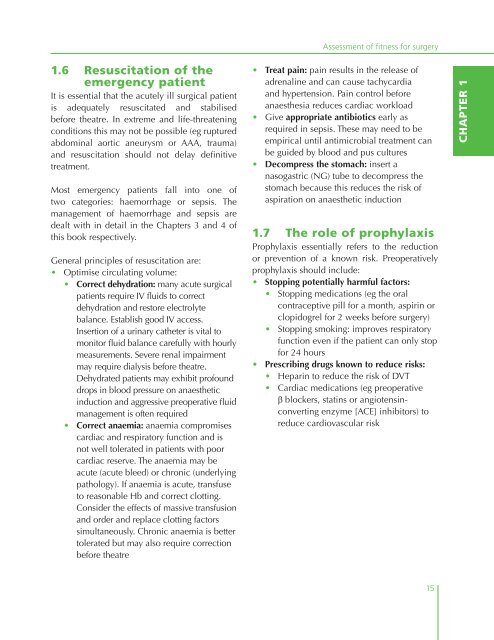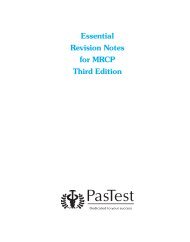MRCS PART A ESSENTIAL REVISION NOTES BOOK 1 - PasTest
MRCS PART A ESSENTIAL REVISION NOTES BOOK 1 - PasTest
MRCS PART A ESSENTIAL REVISION NOTES BOOK 1 - PasTest
- No tags were found...
Create successful ePaper yourself
Turn your PDF publications into a flip-book with our unique Google optimized e-Paper software.
Assessment of fitness for surgery1.6 Resuscitation of theemergency patientIt is essential that the acutely ill surgical patientis adequately resuscitated and stabilisedbefore theatre. In extreme and life-threateningconditions this may not be possible (eg rupturedabdominal aortic aneurysm or AAA, trauma)and resuscitation should not delay definitivetreatment.Most emergency patients fall into one oftwo categories: haemorrhage or sepsis. Themanagement of haemorrhage and sepsis aredealt with in detail in the Chapters 3 and 4 ofthis book respectively.General principles of resuscitation are: Optimise circulating volume: Correct dehydration: many acute surgicalpatients require IV fluids to correctdehydration and restore electrolytebalance. Establish good IV access.Insertion of a urinary catheter is vital tomonitor fluid balance carefully with hourlymeasurements. Severe renal impairmentmay require dialysis before theatre.Dehydrated patients may exhibit profounddrops in blood pressure on anaestheticinduction and aggressive preoperative fluidmanagement is often required Correct anaemia: anaemia compromisescardiac and respiratory function and isnot well tolerated in patients with poorcardiac reserve. The anaemia may beacute (acute bleed) or chronic (underlyingpathology). If anaemia is acute, transfuseto reasonable Hb and correct clotting.Consider the effects of massive transfusionand order and replace clotting factorssimultaneously. Chronic anaemia is bettertolerated but may also require correctionbefore theatreTreat pain: pain results in the release ofadrenaline and can cause tachycardiaand hypertension. Pain control beforeanaesthesia reduces cardiac workloadGive appropriate antibiotics early asrequired in sepsis. These may need to beempirical until antimicrobial treatment canbe guided by blood and pus culturesDecompress the stomach: insert anasogastric (NG) tube to decompress thestomach because this reduces the risk ofaspiration on anaesthetic induction1.7 The role of prophylaxisProphylaxis essentially refers to the reductionor prevention of a known risk. Preoperativelyprophylaxis should include: Stopping potentially harmful factors: Stopping medications (eg the oralcontraceptive pill for a month, aspirin orclopidogrel for 2 weeks before surgery) Stopping smoking: improves respiratoryfunction even if the patient can only stopfor 24 hours Prescribing drugs known to reduce risks: Heparin to reduce the risk of DVT Cardiac medications (eg preoperativeblockers, statins or angiotensinconvertingenzyme [ACE] inhibitors) toreduce cardiovascular riskCHAPTER 115
















